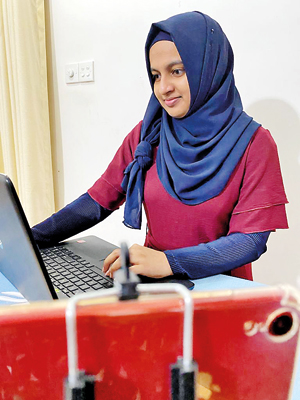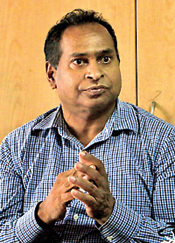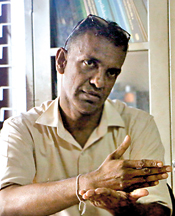Giving ear to the needs of the deaf in a pandemic and after

Social media activist: Husna Naleer
Before her cochlear implants, Husna Naleer could not hear the ambient sounds that texture daily life: the ticking of clocks, the clink of pots and pans, the barking of dogs. Before, her midnight snacking would often wake her parents when she used the microwave. Now, she can recognize the noises and knows to take the food before the microwave pings.
“After the cochlear implants, I could hear the microwave oven being started from the hall. It astounded me that even the button makes sounds when pressed,” she writes in a March 2020 blog post.
Twenty-six-year-old Husna, who has a BA in English and works as a content writer, has been using social media to document life as a deaf person, provide updates on her cochlear implant and tackle stereotypes about the deaf. “I had a lecturer, Kaushalya Perera; she was the first person who encouraged me to come out of my shell,” says Husna,
“There are some deaf people who can sign and talk. There are deaf people who can talk. I wanted to remind people that deaf people are diverse,” explains Husna, who hails from Matale and was diagnosed with severe to profound sensorineural hearing loss as a toddler. She learned to speak thanks to her formative years at Bala Vidyalaya, an Early Intervention Centre in Chennai, India admitting deaf/hearing impaired children below three years of age, which provided a vital foundation and subsequently, a network to rely on.
Her feed on Instagram combines personal updates, infographics for advocacy and awareness and of late, a gradual pivot to video taking into account the demands of the platform algorithms and social media trends. She was unsure of her pronunciation and speech but was encouraged by her family to make videos. She says it took her almost a year to gain the confidence to record herself on video and publish it.
On September 18, 2019, Husna had her first surgery for a cochlear implant. In her blog, (https://www.insightintothedeafworld.com/), she provides updates after her surgery and the effects of the pandemic on follow-ups with the audiologist and doctor. It’s been a long journey. The implant was obtained with assistance from the President’s Fund and took two years to approve. The pandemic has also made follow-ups difficult and delayed many surgeries for those awaiting implants.

Anil Jayawardhane
“Many people think that when someone wears a cochlear implant, they can immediately hear but that’s a misconception,” Husna says. “Cochlear implants and hearing aids are not a cure for deafness. They are tools to access sounds,” she said explaining there is a process of speech therapy and rehabilitation to ascertain if the implant is a success.
In a post, Husna explains that hearing aids can cost anywhere between Rs. 3 lakhs to Rs 1 million and a cochlear, along with the kit similar amounts. Assistive device life expectancy and tech changes have to be taken into account. Additional medical expenses to supplement the process are other costs – paying for the audiologist, visits to the ENT doctor to monitor hearing loss, payment for servicing the assistive device, batteries, ear moulds to monthly subscriptions for captioning software and investments in a smartphone with a telecoil feature which creates a magnetic field that picks up sound and improves the signal-to-noise ratio.
In the aftermath of COVID-19, organizations working with the deaf community have increased their reliance on social media to supplement gaps in public communication, raise awareness about the rights of deaf people and ensure timely updates on recent developments.
Anil Jayawardhane, Secretary of the Sri Lanka Central Federation of the Deaf (SLCFD), explained that they worked in their personal capacity to give out timely news during the first wave of COVID.
“All of a sudden, there was a curfew and we didn’t know as it was not told to us in sign language,” said Anil adding that information often lagged for the deaf community.

K.K. Brayan Susantha
Something that was announced in the morning would only be relayed in sign language at night. Sudden health regulations involving masking and social distancing as well as details about social welfare measures had to be relayed promptly and SLCFD intervened to get this information to deaf communities through their sign language translators on their Facebook page.
Later, ensuring vaccination announcements were relayed was of paramount importance. For deaf people who rely on clear articulation and lip reading to communicate, face masks compounded communication issues. But a lack of internet connectivity and limited access to and knowledge of social media have prevented others from accessing timely information.
There were instances where deaf persons were sent en-masse to quarantine centres, without the rules of the quarantine centre being explained to them. SLCFD also had to liaise with Public Health Inspectors and the Police to obtain dry rations for families who were quarantined and unable to access necessities.
While for most schoolchildren, the offline-online segue has ensured a semblance of education continuity, for many deaf children, the pandemic has marked two years of disruption in education says the SLCDF. The effects of this on a community with already low levels of literacy and grappling with a lack of accessible deaf preschools are yet to be assessed.
The past years have brought about some developments as a result of extensive lobbying, partnerships and on-ground efforts. In November 2021, simultaneous sign language interpretation was provided for the Budget 2022 debate for the first time. In recent years, news bulletins on selected channels have begun providing simultaneous sign language interpretation. Steps were recently taken to start medical tests for driving licences for the deaf. ‘Atha Hitha’ Magazine, a bi-annual publication by Disability Organizations Joint Front (DOJF), an umbrella body of Disability Peoples Organisations in Sri Lanka, outlined the nine criteria under which licences will be assigned, while SLCFD’s Facebook page showed the National Transport Medical Institute, Kandy issuing a medical report required to obtain a driving licence for the deaf.
“A Sign Language Act would help in reducing the problems of education and accessibility,” explains K. K. Brayan Susantha, President of the SLCFD. This has been in the works for over a decade, receiving Cabinet approval multiple times across successive governments and was in the news again in January 2021.
“There are also questions of what happens next. How will resources for this be allocated,” asks Brayan commenting on the fissures between legislation, connecting mechanisms and on-ground implementation in Sri Lanka.
For instance, an October 2020 position paper facilitated by Eastern Social Development Foundation, Batticaloa on gender sensitive service provision and victim centric reparations for women living with disabilities in the Eastern Province examined the challenges in the implementation of the 3% reservation of government employment for persons with disabilities.
It pointed out that audits, with the participation of district level disability groups, are vital to ensure that the quota is being accessed. The quota is futile if the qualifying factors are the same for those with disabilities and those without and if enabling conditions are not cultivated.
“Structurally, if a disabled person does not get specialized quality education, if the family cannot afford the special care, medical care and additional costs of schooling, if girls are not supported for tuition and encouraged to continue schooling after their menstruation, if the buses are not adjusted for persons with disability to access educational facilities, if buildings and toilets do not have disability access, the number of those persons with disabilities who will complete university, nursing, police or teacher training and access this 3% of government employment is going to be minimal. Therefore, all the enabling conditions have to be urgently addressed if this 3% quota is to be an actual employment opportunity,” the paper noted.
There is also a need for up-to-date data on deaf persons in Sri Lanka.
“When we refer to stats, we still speak about the numbers in the 2012 census but it is unclear how far these numbers have changed,” says Chamara Wijesinghe, a sign language interpreter based in Kelaniya. As per the Sri Lanka Department of Census and Statistics (2012), the number of hearing impaired or semi hearing impaired persons in Sri Lanka was 389,077 while there were 180,833 persons with communication disorders.
Unpacking ableism and inclusivity is also a must.
“At any point in the conversation, if I come and tell you that I am disabled or a deaf young woman, you do not get to assert your choice of words,” emphasizes Husna in one of her Instagram videos. “Discovering your disability and identifying yourself is a painful journey ….. Finally I settled down calling myself disabled and a young deaf woman.”
“When people refer to deaf people, they think everything has to be done through the Social Services Department,” commented Anil Jayawardhane, noting a need to reimagine accessibility across all services and to ensure that there are systems for disabled persons to get information during a crisis.
“How can a deaf person obtain the services of an ambulance when needed? We also fall sick. Something as simple as having a messaging service or an alternate number for disabled persons will make all the difference,” said Anil.
(Janaka Ranasinghe assisted with sign language interpretation)
Searching for an ideal partner? Find your soul mate on Hitad.lk, Sri Lanka's favourite marriage proposals page. With Hitad.lk matrimonial advertisements you have access to thousands of ads from potential suitors who are looking for someone just like you.


